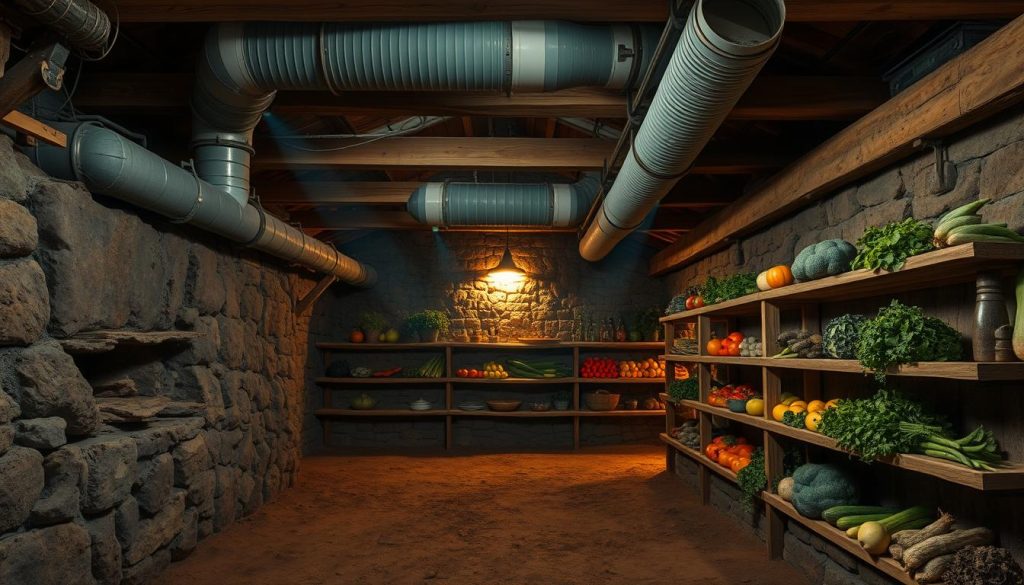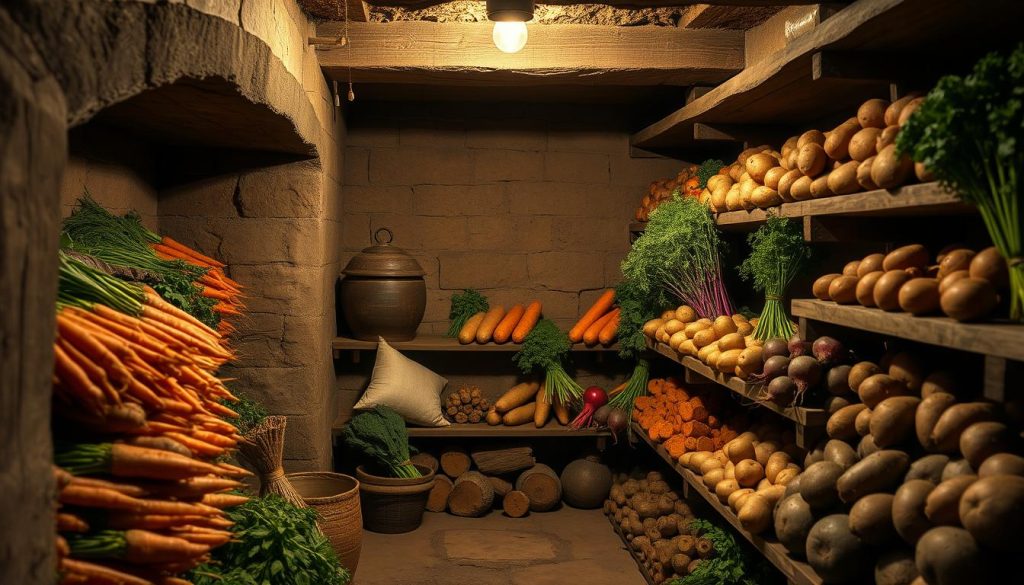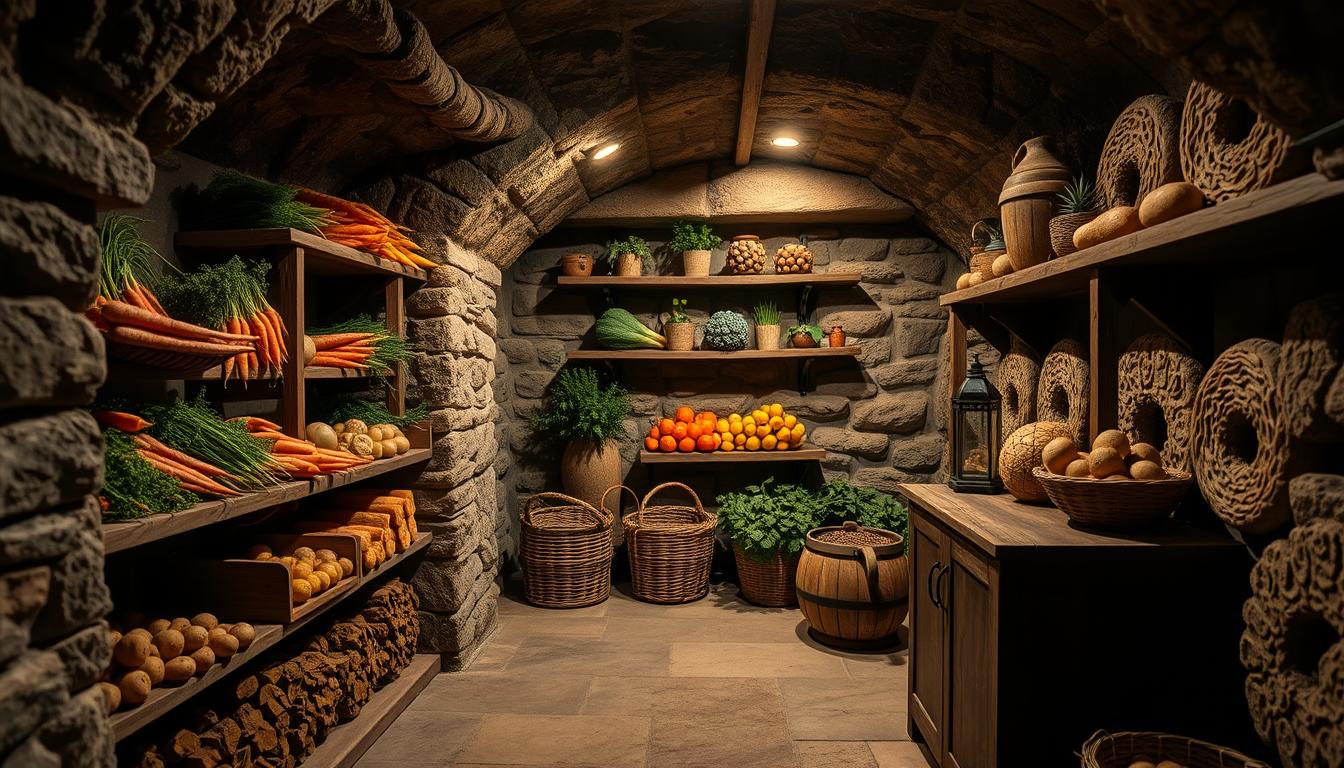Have you thought about making your basement more useful? Turning it into a root cellar can make a big difference. It’s a great way to keep fruits and veggies fresh all year.
This change is good for the planet and keeps your food fresh. Even when it’s cold outside, you’ll have access to fresh produce.
Picture this: walking into your basement and seeing your harvest’s colors and smells. It’s not just a dream. With the right planning, your basement can become a vibrant space for your food.
Let’s explore how to make your basement the perfect place for storing food. We’ll cover the key steps to turn your basement into a root cellar.
What is a Root Cellar and Its Benefits?
A root cellar is a storage space built underground. It’s perfect for keeping different types of produce fresh. For centuries, people have used root cellars to keep food from spoiling.
Understanding the Concept of a Root Cellar
A root cellar uses the earth’s cool temperature and natural humidity. It’s great for storing fruits, veggies, and other perishables. The earth keeps the cellar cool, helping to keep food fresh.
Root cellars need good ventilation, insulation, and smart storage. This helps use space well and keeps food fresh longer.
Benefits of Using a Root Cellar
Using a root cellar has many root cellar advantages. It helps keep food fresh for months, saving money by reducing waste. It also makes you more self-sufficient and sustainable.
Homegrown or locally sourced produce is better for the environment. Root cellars keep food fresh by controlling moisture and temperature.
Ideal Conditions for Root Storage
Root cellars need the right conditions to keep food fresh. The best temperature is between 32-40°F. Humidity should be 85-95%.
Darkness is also key to prevent spoilage. The high humidity in root cellars keeps food from drying out. The cool temperatures slow down bacteria and mold, keeping food safe and fresh.
Assessing Your Basement for Conversion
Starting to turn your basement into a root cellar means first checking it out. You need to look at the space, layout, and if it fits the needs of a root cellar.
Evaluating Space and Layout
First, measure how much space you have. Is it big enough for all the food you want to keep? Think about how you’ll arrange things to make it easy to get to your food. Consider where you’ll put shelves and containers to use every bit of space.
Checking Temperature and Humidity Levels
Then, check the temperature and humidity in your basement. Root cellars work best when it’s cool and not too humid. Use a thermometer and hygrometer to see what your basement is like. Take readings over a few days to see how it changes. This will help you figure out what you need to do to make it perfect for storing food.
Essential Materials for the Conversion
Turning your basement into a root cellar needs the right materials. These materials keep your food fresh and in the best condition. They help create the perfect storage environment.
Types of Containers for Storage
Choosing the right root cellar containers is key. They protect your food from moisture and pests. Here are some good options:
- Wooden Crates: They let air in and keep pests out.
- Plastic Bins: Plastic bins are strong against humidity and easy to clean.
- Clay Pots: They naturally control humidity, making them perfect for root cellars.
Insulation Materials to Consider
Insulation for root cellars keeps the temperature steady. This is vital for keeping your food fresh:
- Foam Board Insulation: It’s great at keeping heat out and is simple to put up.
- Spray Foam: It covers well and insulates well too.
- Fiberglass Batts: A bit old-school, but works well if installed right.
Preparing Your Basement for Storage

Turning your basement into a root cellar begins with preparation. Start by basement clearing and making sure it’s well-ventilated. A clean, organized, and airy space is key for keeping your food fresh.
Clearing Out Unwanted Items
Clearing your basement means getting rid of clutter, debris, and unused items. These can attract pests or spoil your food. Sort through everything and decide what to keep, donate, or throw away.
Get rid of old items and clean surfaces well to remove dust and mold. This step is vital for a clean and pest-free root cellar.
Ensuring Proper Ventilation
Good ventilation for root cellars helps control temperature and humidity. It prevents mold and keeps air fresh. You can use air vents or fans for better air flow.
Natural ventilation works well, but sometimes a small exhaust fan is needed. Use a hygrometer to check humidity levels and adjust ventilation as needed.
Temperature Control and Humidity Management
Keeping your root cellar stable is key to keeping your food fresh. Good temperature and humidity control help your food stay good for longer. Here are some tips for the best cellar climate.
Choosing the Right Heating/Cooling Systems
Choosing the right heating or cooling systems is crucial. Your climate might need passive or active methods. For extreme temperatures, a mix of both is best.
Using Hygrometers for Monitoring
Hygrometers are great for checking humidity in your cellar. They give you constant moisture levels. This helps you adjust as needed, whether adding water or using desiccants.
Choosing Foods to Store in Your Root Cellar

When picking items for your root cellar, think about how long they last and how they handle cold and damp. Picking the right vegetables and foods for storage is key to a successful root cellar.
Best Vegetables for Long-Term Storage
Root vegetables are top choices for long-term storage. Carrots, beets, and potatoes do well in cool, moist places. They’re perfect for keeping for a long time.
Here’s a list of root vegetables perfect for a root cellar:
- Carrots
- Potatoes
- Beets
- Turnips
- Rutabagas
Additional Foods Suitable for Root Cellaring
Other foods also do well in a root cellar. Fruits like apples and pears can last months if stored right. Winter squashes, onions, and garlic are great too because they handle cellar conditions well.
Consider adding these to your root cellar:
- Apples
- Pears
- Winter Squash
- Onions
- Garlic
Before storing, make sure to clean and cure these foods. This step helps them last longer and stay fresh.
Designing the Layout of Your Root Cellar
Creating a good root cellar design means using space well and keeping food fresh. It’s about where you put shelves and how you organize things. This helps you reach what you need easily and keeps air moving.
Shelving Ideas for Maximum Space
Choosing the right root cellar shelving solutions makes a big difference. Here are some ideas:
- Adjustable Shelves: Choose shelves that can be adjusted. This lets you fit different sizes of produce and containers.
- Sturdy Materials: Pick materials like metal or treated wood. They can handle heavy produce and last in humid conditions.
- Wall-Mounted Shelves: Use wall shelves to save floor space. This lets you have more room to move and store things.
Remember to leave space between shelves for air to flow. Good air circulation is key for keeping food fresh for a long time.
Organizing Your Produce Effectively
After setting up your shelving, focus on organized food storage. This makes it easier to find and use what you have. Here are some tips:
- Labeling: Label each shelf and container clearly. This helps you quickly find and use what you need, reducing waste.
- Grouping by Type: Store similar produce together. For example, put root vegetables on one shelf and canned goods on another.
- Accessibility: Put items you use often in easy-to-reach spots. Store things you don’t use as much in harder-to-reach places.
By following these tips, you’ll have a root cellar that’s well-organized. It will use space wisely and keep your food fresh.
Maintenance Tips for a Successful Root Cellar

Keeping your root cellar in top shape is key. Regular care and attention are needed. This ensures your food stays fresh and safe for longer.
Regular Checks and Updates
It’s vital to check your root cellar often. Look at temperature, humidity, and overall conditions. Here’s a simple checklist:
- Check temperature and humidity levels weekly.
- Inspect ventilation systems for blockages.
- Clean and sanitize storage containers monthly.
Regular updates also mean fixing any damage. Make sure seals on doors and windows are good. This keeps the environment just right.
Managing Pests and Mold
Controlling pests in your storage space is critical. Use natural repellents like diatomaceous earth or traps. This helps keep pests away.
To prevent mold, keep moisture levels down and ensure good air flow. A dehumidifier can help keep things dry.
By following these tips, your root cellar will stay effective. Your produce will stay fresh all year round.
Addressing Common Challenges
Turning your basement into a root cellar has its own set of challenges. Two big ones are dealing with humidity and keeping the temperature right. Getting these right helps keep your food fresh for longer.
Dealing with High Humidity
High humidity can cause rot and mildew, ruining your veggies. To fight this, think about getting a dehumidifier. It keeps the moisture just right. Also, use hygrometers to check humidity levels and act fast if needed.
If your cellar is always damp, try using things like charcoal or silica gels to soak up moisture.
Handling Temperature Fluctuations
Keeping the temperature steady in your root cellar is key to avoiding spoilage. Basements can get too hot or cold because of the weather. To fix this, insulate your cellar well.
Using thermostats can also help control the temperature. Always have a thermometer on hand to check and adjust the temperature as needed.
Final Thoughts on Basement Root Cellaring
Turning your basement into a root cellar is more than a clever storage idea. It’s a big step towards living sustainably and eating healthily. By doing this, we cut down on food waste and keep fresh, nutritious food all year. It’s a great way for modern homes to follow sustainable living.
Embracing the Sustainable Lifestyle
Switching to a root cellar for food storage helps us use less non-renewable resources. It cuts down on the need for refrigerators, lowers electricity use, and is better for the planet. Storing food locally means less waste and helps the environment. This change makes us feel connected to our food in a meaningful way.
Encouraging Healthy Eating through Storage
Using root cellars helps us eat healthier by always having fresh veggies and fruits. Having these foods ready makes it easier to eat well. With stored seasonal produce, we can enjoy the taste and health benefits of fresh food all year. This way of eating keeps us healthy and full of energy.

